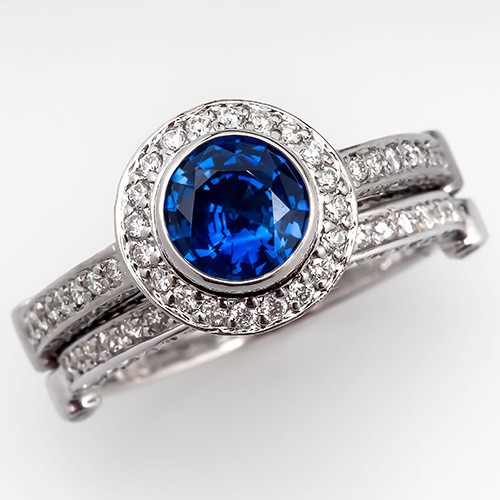
Posted in: Collecting Jewelry
 Blue sapphires command retail prices ranging anywhere from $50 and $1,200 per carat. Jeweler set their prices according to several factors. As with all gemstones besides diamonds, color remains the most important factor. In addition, blue sapphires are graded on clarity, cut, and carat weight. In this article, you'll read about how color and clarity affect the price of blue sapphires.
Blue sapphires command retail prices ranging anywhere from $50 and $1,200 per carat. Jeweler set their prices according to several factors. As with all gemstones besides diamonds, color remains the most important factor. In addition, blue sapphires are graded on clarity, cut, and carat weight. In this article, you'll read about how color and clarity affect the price of blue sapphires.
Color
Blue sapphires range in color from pale sky blue to deep dark blue, sometimes with greenish or violet overtones. In a discussion of color as a pricing factor for sapphires, experts look at three elements. First of all, hue. Then saturation and tone. According to the GIA, the most coveted blue sapphires possess Strong, Vivid saturation, with a velvety blue or violet-blue hue and a Medium to Medium-Dark tone. (source) Another factor that determines price is color zoning, a feature common to sapphires. I will explain color zoning here, as well.Hue
Hue refers the shade of color you see radiating out from the top of the stone.Saturation
Saturation specifies how pure and intense the stone's color appears. Specifically, it represents the amount of color present in the stone.Tone
Tone describes color in terms of light and dark. Sometimes light blue sapphires appear wan or washed out. On the other hand, if the tone is too dark, they appear dead and lifeless. Therefore, Medium to Medium-Dark tones are the most valuable.Color Zoning in Blue Sapphires
According to the GIA, angular zones of dark and light blue often occur in blue sapphires. This means that when viewed at different angles, the color shifts from dark to light. When cut properly to reflect the darkest color zones to the eye, this common characteristic rarely affects price. However, if cut poorly, color zoning can depreciate a gemstone's value. Not surprisingly, stones exhibiting an even distribution of color throughout command the highest prices per carat.
Clarity
After color, clarity proves the next most important factor in determining the value of your sapphire. Clarity refers to the presence (or absence) of inclusions within the stone, whether visible to the eye, or under magnification. Inclusions refer to any flaw, damage, or additional elements "included" in the structure of the stone during its formation. (source) Such defects include mineral elements woven into the crystal structure, minuscule gas bubbles, trapped liquids, and more. Almost all sapphires contain needle-like inclusions, sometimes referred to as silk. The GIA states that "blue sapphires with extremely high clarity are rare, and very valuable." (source) In other words, you're not likely to come across one while browsing online. For this reason, experts classify sapphires as Type II stones. As a result, according to GemFix, gemological laboratories never grade blue sapphires as 'Flawless.' Therefore, the highest grade given for blue sapphires is VVS (very, very slightly included), also called Eye Clean. (source) The term is fairly self-explanatory. When looking at a sapphire under natural light, the naked eye cannot detect these internal flaws. However, under magnification they become obvious. Because natural sapphires always contain such inclusions, the absence of internal flaws proves a red flag for imitations. To determine a clarity grade, experts take into account the number of inclusions, as well as their size and location within the stone. Obviously, a stone riddled with inclusions, even those invisible to the eye, commands a lower price than one with very few inclusions. Furthermore, a flaw in the center of the stone will decrease the price. However, a flaw on the edge of a stone might not since it could be camouflaged by the jewel's setting. (source) Now you know how Color and Clarity affect the price and value of blue sapphires. Click here to read the next article about how Cut and Carat Weight play their role. ~Angela Magnotti Andrews4 years ago
7 view(s) 